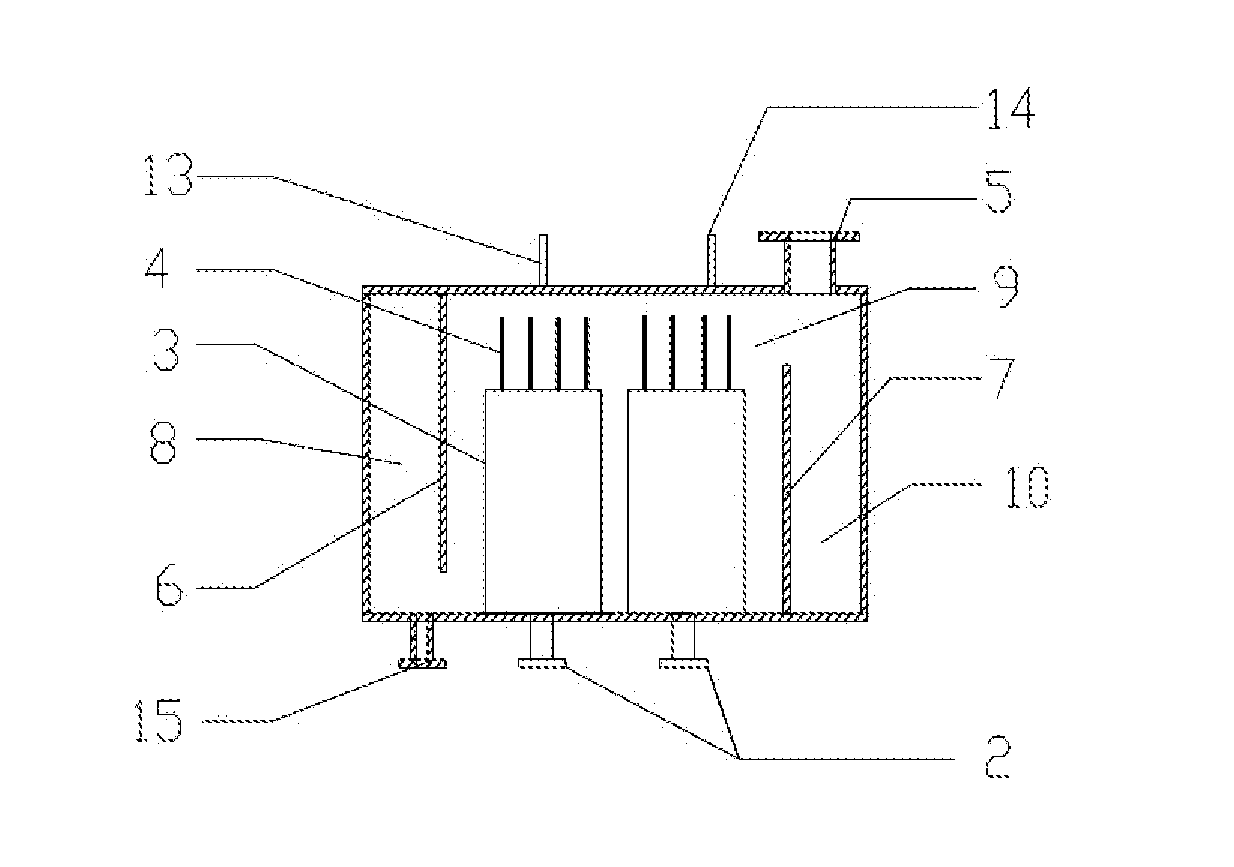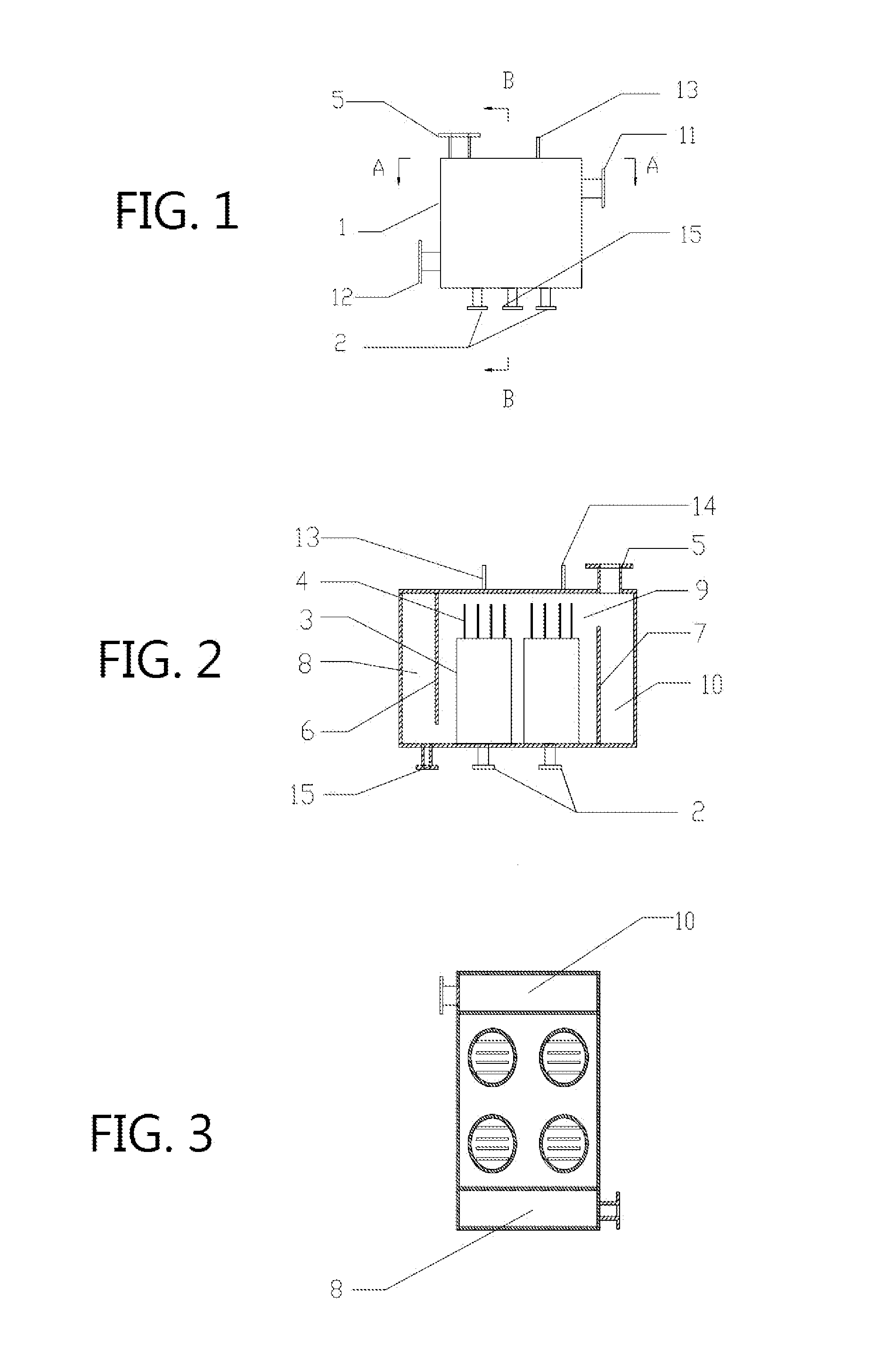Nanocatalytic electrolysis and flocculation apparatus
a technology of electrolysis and electrolysis chamber, which is applied in the field of electrolysis flocculation apparatus, can solve the problems of high operating cost, secondary pollution of the environment, and large quantity, and achieve the effects of reducing sludge discharge, reducing material consumption, and saving water treatment costs
- Summary
- Abstract
- Description
- Claims
- Application Information
AI Technical Summary
Benefits of technology
Problems solved by technology
Method used
Image
Examples
embodiment 1
Preferred Embodiment 1
For Fresh Water Purification and Disinfection Treatment Effect
[0073]Fresh water pump is provided in the nanocatalytic electrolysis and flocculation apparatus. The voltage between the electrodes is 5 to 8V. Electrolyte density is 10 to 200 mA / cm2. Fresh water is kept in the nanocatalytic electrolysis and flocculation apparatus for 0.5 to 1 minute. Electricity consumed for fresh water electrolysis is controlled at 0.009 to 0.010 degree / m3. Table 1 of FIG. 4 shows results before treatment (untreated fresh water indicator) and Table 2 of FIG. 5 shows results after treatment by the nanocatalytic electrolysis and flocculation apparatus.
embodiment 2
Preferred Embodiment 2
Purification and Disinfection of the Water Treatment Effect
[0074]Sea water pump is provided in the nanocatalytic electrolysis and flocculation apparatus. The voltage between the electrodes is 3 to 5V, electrolyte density is of 10 to 260 mA / cm2, sea water is kept in the nanocatalytic electrolysis and flocculation apparatus for 0.5 to 1 minute, and the electricity consumption of the electrolytic water is controlled at 0.003 to 0.004 degree / m3. Table 3 of FIG. 6 shows results before treatment (untreated sea water indicator) and Table 4 of FIG. 7 shows results after treatment by the nanocatalytic electrolysis and flocculation apparatus.
embodiment 3
Preferred Embodiment 3
Depth Treatment of Dyeing Wastewater Treatment Effect
[0075]Secondary clarifier dyeing wastewater after A / O processing flows to the nanocatalytic electrolysis and flocculation apparatus, the voltage between the electrodes is 3 to 6V, electrolysis density is 10 to 300 mA / cm2 regarding catalytic electrolysis, keeping water in the nanocatalytic electrolysis and flocculation apparatus for 2 to 5 min, the electricity consumption of electrolytic water is controlled at 0.8 to 1.0 degrees / m3. Table 5 of FIG. 8 shows results before treatment (mixed pools of untreated wastewater dyeing synthetic indicators) and Table 6 of FIG. 9 shows results after treatment (nano-catalytic electrolysis treatment after dyeing wastewater indicators).
PUM
| Property | Measurement | Unit |
|---|---|---|
| thickness | aaaaa | aaaaa |
| current density | aaaaa | aaaaa |
| electric potential | aaaaa | aaaaa |
Abstract
Description
Claims
Application Information
 Login to View More
Login to View More - R&D
- Intellectual Property
- Life Sciences
- Materials
- Tech Scout
- Unparalleled Data Quality
- Higher Quality Content
- 60% Fewer Hallucinations
Browse by: Latest US Patents, China's latest patents, Technical Efficacy Thesaurus, Application Domain, Technology Topic, Popular Technical Reports.
© 2025 PatSnap. All rights reserved.Legal|Privacy policy|Modern Slavery Act Transparency Statement|Sitemap|About US| Contact US: help@patsnap.com



